 Previous Article
Previous Article
Hollow vs. Solid Composite Decking A UK Expert's Guide (2025)
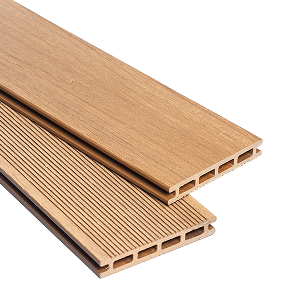
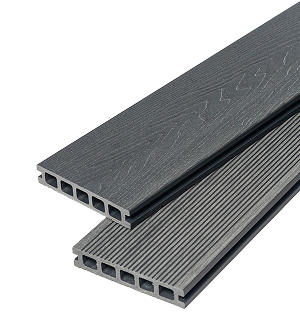
So, you’re researching composite decking and wondering which option is the best fit for your project. The choice can be overwhelming. We get it. At Ultra Decking, our goal is to be transparent and provide you with the best guidance to help you choose the decking that truly aligns with your needs and personal preferences.
The most important thing to remember is that the “best” decking depends entirely on your individual requirements and the specifics of your project. There are countless brands out there, and as a brand, we won’t list them all. The truth is that every product has its own unique strengths and weaknesses.
A top tip: When reading reviews, focus on those from customers who have had their decking for a year or two. This is when any potential issues, especially with cheaper, lower-quality products, start to show. fall into the trap of compromising on quality to save money. As the old saying goes: “buy cheap, buy twice”
| Feature | Uncapped (First-Generation) | Capped (Second-Generation) |
|---|---|---|
|
|

|
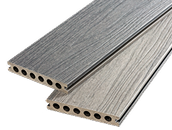
|
| Price | Lower (More budget-friendly) | Higher (Premium option) |
| Maintenance | Regular cleaning required to prevent mould/mildew. | Ultra-low maintenance. Resists stains and mould. |
| Appearance | Good. Natural wood-fibre surface | Excellent. Protective layer maintains 'like-new' look for longer. |
| Fade Resistance | Good. Will lighten up to 30% in the first 6 months. | Excellent. Minimal colour change over its lifespan. |
| Best For | Budget-conscious projects; those who don't mind seasonal cleaning. | Busy families; low-maintenance focus; high-traffic areas. |
Over the years, we’ve helped thousands of customers find their perfect composite decking. The key factors that always come up are budget, maintenance, quality, fade and slip resistance, how long you plan to stay in your home, and the installation area itself.
To help steer you in the right direction, we’ve broken down what we consider to be the best options based on what matters most to our customers.
Before diving in, it’s essential to understand the two main options you’ll face: uncapped and capped. These are separated by cost and performance and are the starting point for every decision.
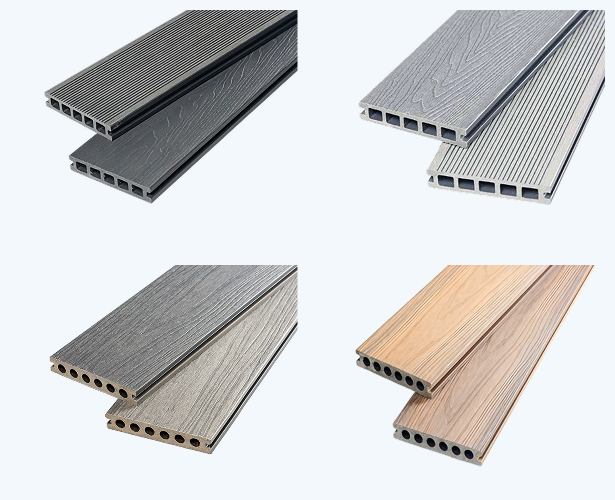
This was the first type of composite decking to enter the market several decades ago. It remains extremely popular in the U.K. due to its price, long-lasting colour, and design options. However, because its surface contains wood fibres, it needs regular cleaning (though no sealing, staining, or painting required) to keep it looking its best.
This type was launched to address the drawbacks of the first generation. It offers ultra-low maintenance, requiring only seasonal cleaning or more if you’ve installed it near a lot of plants and vegetation. Thanks to a protective outer layer, capped composite decking boards have increased moisture and stain resistance, making it the perfect “fit and forget” solution for busy families or those who love to host outdoor events without the worry of spillages on their decking

Overall Quality
What does “quality” mean to you? We address it in two ways.
The primary difference in quality over time relates to the board’s surface. Capped (second-generation) decking has a protective outer layer that resists weathering, while uncapped (first-generation) decking has a wood-fibre surface that requires more cleaning to maintain its appearance.
Capped decking on the other hand, maintains its appearance remarkably well. To the naked eye, the colour can look unchanged even after years of use. The added benefits of stain resistance and low moisture absorption make a huge difference to its longevity. It’s no surprise that capped decking dominates the market in the USA, where consumers have largely moved away from first-generation boards due to their shortcomings.
Secondly, the quality of the supplier plays a crucial role. The brand of second-generation decking you purchase can greatly impact its quality and expected service life.
Expert View: Having visited countless projects over the years, our personal recommendation is for capped composite boards. We’ve simply seen that they hold their ‘like-new’ appearance for much longer, making them a better long-term investment in our opinion.
This is a question customers have rightfully asked for many years, given the mixed messages some suppliers are providing. Some say that solid composite decking boards offer ultimate performance, while others say hollow boards are the perfect mix of performance and cost.
The reality is, both comments are correct. What really matters are your expectations and needs.
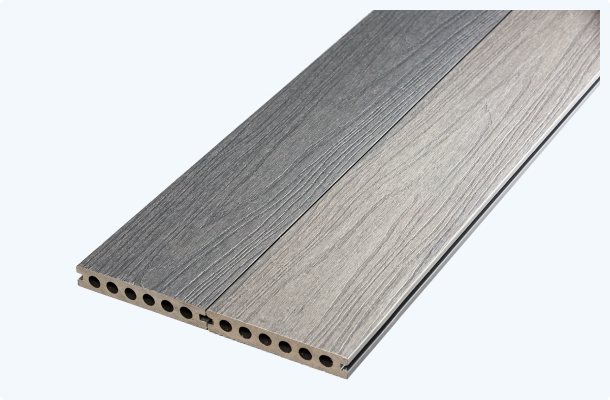
If you are looking for a lasting solution that will serve you well for 10+ years, then hollow core boards are a great choice. They were manufactured to reduce costs for homeowners and make composite decking more affordable, which is exactly what they’ve done. Having served customers for almost a decade, we know hollow composite decking boards are perfectly designed for this purpose.

If cost isn’t an issue and ultimate performance is your key driver, then there’s no doubt solid boards should be your first choice. They can last for decades and are extremely durable, outperforming hollow boards on strength by over 40%.
Top Tip: For customers looking for a 10-year+ solution, our personal choice is a square hollow core. For the best of both worlds, a circular hollow core takes performance from both solid and hollow designs

If minimal maintenance is your top priority, we recommend second-generation capped (or shielded) composite decking. Capped composite decking, for example, offers ultra-low maintenance. A periodic clean with a soft brush and warm, soapy water three or four times a year is all it takes to maintain its best appearance for 25 years and beyond.
The latest shielded technology not only provides low maintenance but also ensures long-lasting colour stability and resistance to staining, mould, and mildew. However, it’s important to note that some have marketed this decking as scratch resistant. This claim isn’t entirely accurate, and it shouldn’t be purchased solely on that basis.

If keeping the board’s colour over its lifetime is a key factor, then capped composite decking is easily our recommendation.
First-generation boards do offer fade resistance, but because they don’t have a protective shield, they go through a natural weathering process in the first 6 months of service life. In short, the colour will lighten by up to 30% and then settle. Don’t panic! This doesn’t mean they lose all their colour. If you understand this, you can plan for it. Lighter colours like light grey will turn to an almost white grey, which some customers prefer. If you want a specific shade, we recommend choosing a darker colour to reach your desired appearance over time
Second-generation capped boards do not go through this significant colour change and will retain their purchased colour for decades, thanks to the UV resistance provided by the outer shield.

If slip resistance is your primary concern, we assume the deck will be near a swimming pool or hot tub. In this case, the board’s strength and its water-repellent properties are the main considerations.
To support the weight of a hot tub, it’s crucial to choose a board with either a hollow circular or solid core. Our professional recommendation would be a circular hollow core, as it allows for thermal expansion while maintaining strength. However, we strongly recommend reducing the joist centres from 300mm to 150mm to support the weight of a filled hot tub with both a solid and circular hollow core composite decking board.
For slip resistance itself, our recommendation leans towards a first-generation board with a wood grain or thin grooved finish. Wood grain boards undergo a brushing process during manufacturing that enhances slip resistance. Grooved boards also offer excellent slip resistance, achieving a PTV (Pendulum Test Value) score of 45. Additionally, the HDPE plastic composition helps repel water, making the boards less likely to freeze and become slippery in winter.
N.B: Slip-resistant and slip-proof are not the same thing. Always exercise caution on any wet surface.
Now for the fun part. Let’s look at how to match the right product to your vision and budget.

If your primary focus is cost and you’re weighing up the options between timber and composite, we recommend considering first-generation composite decking, uncapped composite decking like classic wood grain and classic grooved works well for customers on a budget. This range offers all the advantages of composite decking at a comparable upfront cost to wood, but without compromising on quality. It was specifically designed for UK homes, featuring a robust 22mm deep square hollow core and a 10-year limited warranty, but can last much longer with the regular maintenance and cleaning.
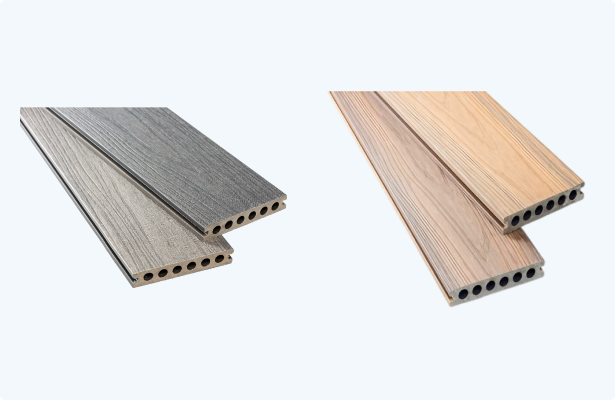
This is mostly down to personal choice, but keep a few things in mind:
There are no visible screw heads on your deck, providing a clean, high-end look
This method doesn’t puncture the top surface of the board, maintaining its protective layer.
With certain plastic T-Clips, a single damaged board can often be replaced without ripping up the rest of the deck.
Top Tip: If opting for first generation composite decking and you want to keep your decking cooler over its lifetime. It’s worth considering choosing darker colours initially as the colour will lighten during the first 6 months of service and continue to lighten, albeit at a slower rate during the decking boards life of service.

The length of your boards is an important, but often overlooked, detail. Why does it matter? It plays a huge role in the overall finish. Using longer boards allows for continuous runs, creating a cleaner, more seamless design. If a seamless look is on your list, be sure to check what lengths are available.
In terms of design, the classic grooved and wood grain finishes have stood the test of time and remain the most popular choices. If you want to set your project apart, you can explore mixed colours with realistic wood grain finishes, like those leading suppliers capped and uncapped mixed colour collections, these offer the most natural-looking boards on the market.
Top Tip: While most installations benefit from the seamless look of long boards, don’t overlook shorter lengths for complex designs. If you’re creating a pattern like herringbone, using shorter boards is a smart way to reduce waste and manage your budget effectively.

When it comes to installation, you have a choice of a decking board that makes use of a hidden fastener system or a decking board that requires screwing through the top of the decking board down to the joists that form part of the sub-structure.
Composite decking boards that make use of a hidden clip-and-screw system are the most common choice for a clean, seamless look with no fixings or screws on display
Some decking boards with no hidden fastener solution are almost always solid. These types of decking boards allow for faster installation by screwing directly through the top of the board. This is less common in the UK for domestic projects due to the higher cost of solid boards.
Finally, don’t forget accessories! If you want matching balustrades or edging, you must check that your chosen supplier offers compatible options in the same colour. Do your research to ensure you can get a coherent look.

All composite decking, if manufactured with the use of Grade A raw materials and high-quality recycled plastic and wood fibres, will offer excellent value for money. A few important questions to ask your supplier:
Most reputable suppliers can provide test reports and certifications. Look for products that have been independently tested to key industry standards, such as EN15534.
Top Tip: You can even do a simple home test: submerge a sample in continual boiling water for 12-24 hours. A low-quality board will likely show cracks in its core.
Expert Tip: Perform a Home Scratch Test. Once you receive samples, don’t be afraid to test them yourself. Use the edge of a key or coin to apply firm pressure to the surface of each board. This simple, real-world test will give you the best possible idea of how different brands will stand up to everyday wear and tear from furniture, pets, and garden tools.

Think about your garden. Is it close to the sea, a forest, or lots of trees?
Areas with high vegetation are prone to mould and mildew. For these projects, we would strongly recommend capped composite decking. Its shielded surface resists mould growth and requires significantly less maintenance than a first-generation board, which would need more frequent upkeep in these conditions.
Ultimately, the choice comes down to your personal priorities. If you’re working to a budget, can handle some regular cleaning, and don’t mind a little colour fade, then uncapped first-generation boards will suit you perfectly.
However, if you prioritise long-lasting colour, minimal maintenance, and stain resistance—especially for a busy family home—then capped second-generation decking is our professional recommendation.
 Previous Article
Previous Article
Hollow vs. Solid Composite Decking A UK Expert's Guide (2025)

A UK Homeowner's Guide to Replacing Wood Decking with Composite (2025)